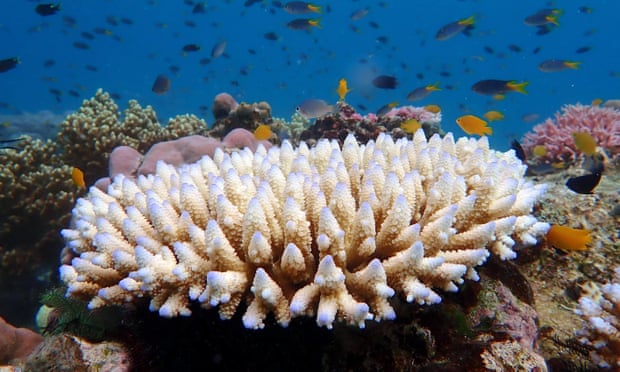The Great Barrier Reef has suffered its biggest annual drop in live coral in two out of three areas monitored by scientists since 1986, a new report has revealed.
The Australian Institute of Marine Science (Aims) report is the first to comprehensively document the devastating impacts of the early 2024 mass coral bleaching event – the most widespread and severe on record for the Great Barrier Reef.
In the months that followed that event, scientists described a “graveyard of corals” around Lizard Island in the north and a study recorded the death of 40% of corals at One Tree Island in the south.
Aims has conducted annual in-water surveys of the world’s biggest reef system since 1986, checking the health and extent of corals.
Sign up: AU Breaking News email
This year’s survey report found that in the reef’s northern section – between Cooktown and the tip of Cape York – bleaching, two cyclones and associated flooding had caused coral cover to fall by 25%.
In the southern section, from Mackay to just north of Bundaberg, coral cover had fallen by 30%. The northern and southern zones suffered the highest annual drops on record.
Coral cover fell by 13% in the central section, which had escaped the worst of the heat in 2024.
Dr Mike Emslie, who leads the long-term reef monitoring program at Aims, said coral cover was becoming more volatile.
“It has been a pretty sobering year of surveys with the biggest impacts I have seen in the 30-plus years I have been doing this,” he said.
“This volatility is very likely a sign of an unstable system. That’s our real concern. We’re starting to see record highs in coral cover that quickly get turned around to record falls.”
Quick Guide
What is coral bleaching?
Show

Coral bleaching describes a process whereby the coral animal expels the algae that live in its tissues and give it its colour and much of its nutrients.
Without its algae, a coral’s white skeleton can be seen through its translucent flesh, giving off a bleached appearance.
Mass coral bleaching over large areas, first noticed in the 1980s around the Caribbean, is caused by rising ocean temperatures.
Some corals also display fluorescent colours under stress when they release a pigment that filters light. Sunlight also plays a role in triggering bleaching.
Corals can survive bleaching if temperatures are not too extreme or prolonged. But extreme marine heatwaves can kill corals outright.
Coral bleaching can also have sub-lethal effects, including increased susceptibility to disease and reduced rates of growth and reproduction.
Scientists say the gaps between bleaching events are becoming too short to allow reefs to recover.
Coral reefs are considered one of the planet’s ecosystems most at risk from global heating. Reefs support fisheries that feed hundreds of millions of people, as well as supporting major tourism industries.
The world’s biggest coral reef system – Australia’s Great Barrier Reef – has suffered seven mass bleaching events since 1998, of which five were in the past decade.
With relatively benign impacts from cyclones and bleaching in the five years before the 2024 event, coral cover had reached record levels in some places.
But that recovery, Emslie said, was largely driven by fast-growing acropora corals that were more susceptible to heat stress.
“We had said it could all get turned around in one year and, low and behold, here we are,” he said, adding that coral cover was now mostly back in line with long-term averages.
‘Closer and closer’
The 2024 and 2025 events were part of an ongoing global mass coral bleaching event that led to more than 80% of the planet’s reefs being hit with enough heat to cause bleaching, affecting corals in at least 82 countries and territories.
A study last year found ocean temperatures on the Great Barrier Reef were likely at their hottest for at least 400 years and were an “existential threat” to the Unesco World Heritage-listed reef.
after newsletter promotion
Widespread mass bleaching of the Great Barrier Reef was first seen in 1998 and happened again in 2002, 2016, 2017, 2020, 2022, 2024 and 2025.
Emslie said: “These impacts we are seeing are serious and substantial and the bleaching events are coming closer and closer together.
“We will ultimately get to a tipping point where coral cover can’t bounce back because disturbances come so quickly that there’s no time left for recovery.
“We have to mitigate the root causes of the problem and reduce emissions and stabilise temperatures.”
The Aims report comes a month before the federal government is due to reveal its emissions reduction target for 2035.
The Albanese government promised Unesco last year it would “set successively more ambitious emissions reduction targets” that would be “in alignment with efforts to limit global temperature increase to 1.5C”.
Last week, the Climate Change Authority, which will advise the government on what target to set, released a report that said holding warming “as close as possible to 1.5C” was key to addressing the threats facing the reef.
Richard Leck, head of oceans at WWF Australia, said the government needed to set a target consistent with 1.5C.
“This is the one action the government can take to give the reef a fighting chance.”
Source link


